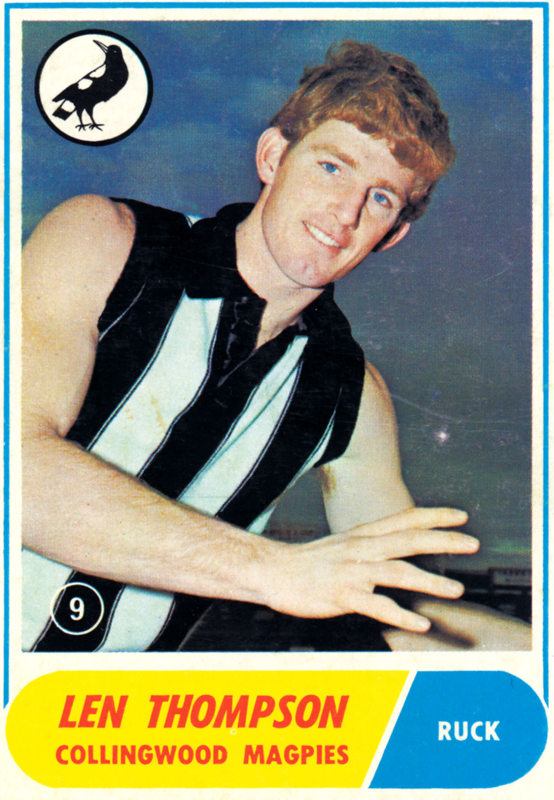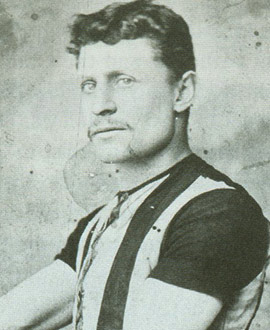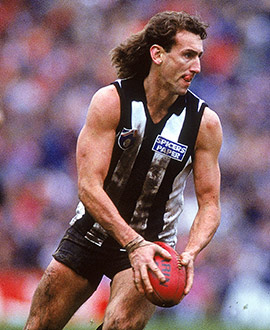By: Glenn McFarlane
Preston East High School one day; conquering Victoria Park the next.
A 17-year-old student from the northern suburbs played his first match for Collingwood in 1979 and as far as debut games go, they don't come much more memorable or any more lop-sided.
The kid's name was Peter Daicos.
And it's fair to say that no footballer in the history of the game has ever started out with such an emphatic first-up victory.
The first of Daicos' 250 games came in round four, 1979, and it coincided with one of the most complete performances in the history of the Collingwood Football Club, albeit against a team in serious trouble.
The Magpies may have lost two of their first matches of that season heading into the April 28 fixture against St Kilda, but it only made them hungrier to make a statement.
On the Friday before the game, Daicos was studying the books as he worked towards his HSC. On the Saturday, he was proving that football was always going to be more than just a weekend hobby.
To that stage, the kid from Preston RSL had shown great potential in the reserves and Under 19s. He played the final six games of 1977 with the Under 19s - he was not yet 16 then - and then played 12 games for the "thirds" and 10 with the reserves in 1978.
Those fans who had thrived on watching the curtain-raisers knew it was only a matter of time before he would make his debut as a Collingwood senior player. And Tom Hafey couldn’t have chosen a better start for the kid wearing the No.35 jumper.
The Saints were almost a shambles at that time, with question marks surrounding the club's finances and its ability to pay their players.
Incredibly, St Kilda had beaten the previous year's reigning premier Hawthorn in round one, but two others losses against Essendon and Footscray left them at 1-2 before the Collingwood game. That left former Magpie captain and the Sun's Kiss of Death columnist Lou Richards forecasting a pretty dull sort of affair between the two sides.
Richards wrote: "Collingwood will stagger and stumble to a win over St Kilda at Victoria Park today. That's how badly the Saints are going. Collingwood's rovers and ruck rovers are so badly out of form that Peter Moore's good work in the ruck is wasted."
He would change his tune later that afternoon. His copy for the Monday edition of the paper would describe "the most one-sided football match I have ever seen. I will simply add that I have never seen a worse performance by a St Kilda side and I have seen the Saints put in some shockers over the years.
"It was horrible, ugly, awful...except for Collingwood supporters who savoured every excruciating minute of the debacle."
Officially, there were 29,380 fans who clicked through the Victoria Park turnstiles. In the years after, there were be many, many more than that number professing they were there to witness the “birth” of a champion, and a date with history.
Another Magpie youngster was getting another chance that day. He was a full year older than Daicos, yet also from the northern suburbs. He wasn't initially selected, though he had played five games the previous year, including in two finals.
But the man who was now wearing the No.22 jumper was a late inclusion for the match against the Saints when rover Bill Valli was ruled out with shingles.
The 18-year-old was Tony Shaw.
He was playing his sixth game and, like Daicos, he would show enough that afternoon to prove he had a big future.
Daicos was named in the centre; Shaw would start in the forward pocket, and change as second rover with his brother Ray, who was Collingwood's captain.
If debutants dream about getting their hands on the ball early, Daicos got his wish. As Collingwood historian and author Michael Roberts later recorded: "With his first touch, he (Daicos) pirouettes away from several opponents, leaving them grasping at air, and heads for goal. Ironically, that first kick sails out on the full, but not much else goes wrong for the youngster."
Collingwood started the game full of running, with Moore dominating in the ruck, and the midfielders ripping the ball out of the middle with relentless ease. This gave the forwards every chance.
Within the first eight minutes of the game, the Magpies had four straight goals.
The Herald said the early onslaught "left the Saints defenders wondering what (had) hit them."
Craig Davis was playing his fourth game for Collingwood, after previous stints at Carlton and North Melbourne. He had kicked seven goals for the Magpies against Hawthorn in round two, and got off to a perfect start kicking the first two goals against the Saints.
The first came as he "took the ball off a pack" and slotted it through with his second coming from a mark that had been driven long by Russell Ohlsen, who was playing his second game in black and white, after previously playing for Carlton.
Ohlsen got himself into the action with a first-term goal as well - one of seven the Magpies kicked - with Craig Stewart scoring two of them. Ray Shaw and Rene Kink also kicked one each in the opening term. Shaw's goal was a long one, as he stretched his right foot as much as he could. Kink's was an exercise in pure strength.
The Herald described how Kevin Morris, one of six Magpies that day who started their careers elsewhere in the VFL, got the ball down to Kink, who was "grabbed around the neck...the tackle didn't even halt the 'Incredible Hunk' who just kept streaming ahead to boot another goal."
It took St Kilda 17 minutes to "finally give the scoreboard attendant some work to do" and the visitors would score only 1.1 (7) to the home side's 7.7 (49) in the first term.
Frustration was starting to set in for the Saints. Peter Moore "hit the turf behind play" and in the ensuing conflict that followed, Terry Wight was also "spreadeagled" by the same player, Don Discher.
Discher would be later be suspended for two weeks on each count, leaving him with a four-week ‘holiday’ for his frustration.
Collingwood's defence didn't get much work in the opening term, but a mistake in the early moments of the second quarter gave the Saints a rare opportunity. It came when Peter McCormack, who had been solid in defence, mistimed a pass in the back half that was intercepted by the Saints' second gamer, Gary McDonald. And McDonald slotted through his club's second goal.
Still, that was a rarity, as Collingwood maintained the pressure and continued to have the Victoria Park scoreboard operators working overtime. Or as the Herald suggested: "the Collingwood slaughter continued."
Ray Shaw "snapped a goal under pressure" (not that there was a lot of pressure) then followed it up with another goal a minute later. Davis kicked his third goal, as did Stewart, while Michael Woolnough, in his third game with the club since his move from Geelong, got into the act when he stormed downfield to put through a long goal. He would kick a second as well.
By the 20-minute-mark of the second term, the difference was out to 74 points. It was an even 12 goals at the half-time break - 13.11 (89) to 2.5 (17).
As Tom Hafey spoke to the players in the rooms at half-time, fans talked in glowingly terms about the kid wearing the No. 35. He looked to have that something special - talent meshed with temperament. But if the fans thought that the first hour of play was good, it would only get better, so much better.
For St Kilda, it would only get bleaker. Four goals in the first six minutes of the third term pushed the margin out further. Moore kicked his first, and then had a hand in setting up one for Morris, while Stewart put through another.
Such was the ease of the contest that defender Kevin Worthington was able to sneak down to attack to kick a goal - his eighth career goal- in what was his 50th VFL game.
A boo went around Victoria Park when Ray Shaw slammed through a behind he probably should have converted, though he "made amends" a few minutes later with a goal.
Kink helped to set up a goal for Derek Shaw, whose left foot snap brought about Collingwood's 20th goal.
At three-quarter-time, the margin was out to a ridiculous 118 points. But if the long-suffering Saints' supporters, some of them making their way out of the ground and across to Victoria Park Station, thought the massacre was over, they would be sorely mistaken.
Like a hound with the scent of blood, the Magpies set in train a record-breaking final quarter that stunned the crowd. Ten goals to nil - 10.5 to be exact - pushed the final deficit out to a record 178 points.
That victory broke a 70-year record for the greatest winning margin of any team against another, passing the 171-point margin recorded by South Melbourne over St Kilda in 1919.
It would be a short-lived record. Just 13 rounds later, Fitzroy kicked the highest score in VFL football to that stage and thrashed Melbourne by 190 points.
Yet it still remains as the third highest winning margin in history.
That Collingwood score 31.21 (207) was, at the time, the club's highest score. It, too, would be surpassed a year later when the Magpies kicked 32.19 (211) to beat - you guessed it, St Kilda - by 104 points.
But that famous 1979 game still lives as Collingwood's greatest winning margin - which knocked off the 147-point margin against Essendon in 1971 - and it also remains St Kilda's greatest losing margin.
Davis finished with six goals, as did Stewart. Rene Kick kicked five goals, while the skipper had four and Derek Shaw finished with three. In all, the Magpies had 11 individual goal kickers for their 31.21 score.
Incredibly, the kid who shone so brightly that day, having 26 disposals, and kicking four behinds, failed to kick a goal.
Daicos would kick 549 goals in a brilliant Collingwood career - from all parts of Victoria Park and elsewhere - but his first goal would not come until his second game, against Footscray, a week later.
Regardless of that, those who had seen the first two hours of Daicos' time in senior black and white colours knew they had witnessed something special.
Trevor Grant would write later in the Herald Sun: "Those who watched this tyro in his first season (1979) waltz through the eye of the centre-square cyclone and make lace imprints on the full-forward's chest, were certain they had a young man who could take the game to a higher plane."
Greater awards and honours would come for Daicos over the next decade and a bit, but few would have felt as special as the small television set he won from 'World of Sport' the following day for providing the best highlights of the round.
There were more - many, many more - to come.
That must have made some story to tell when Daicos returned to school on the Monday morning.













